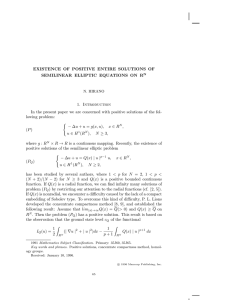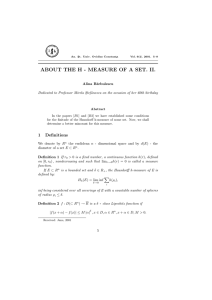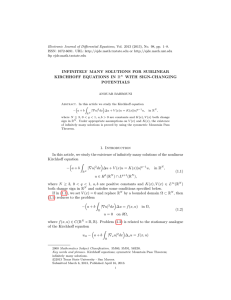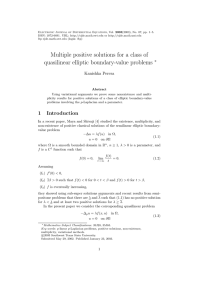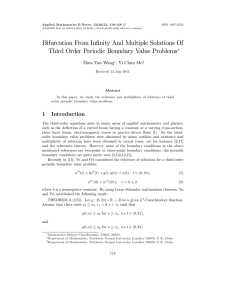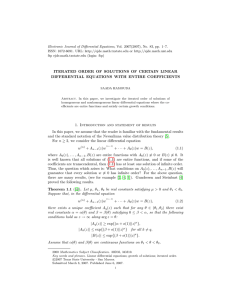Electronic Journal of Differential Equations, Vol. 2009(2009), No. 44, pp.... ISSN: 1072-6691. URL: or
advertisement
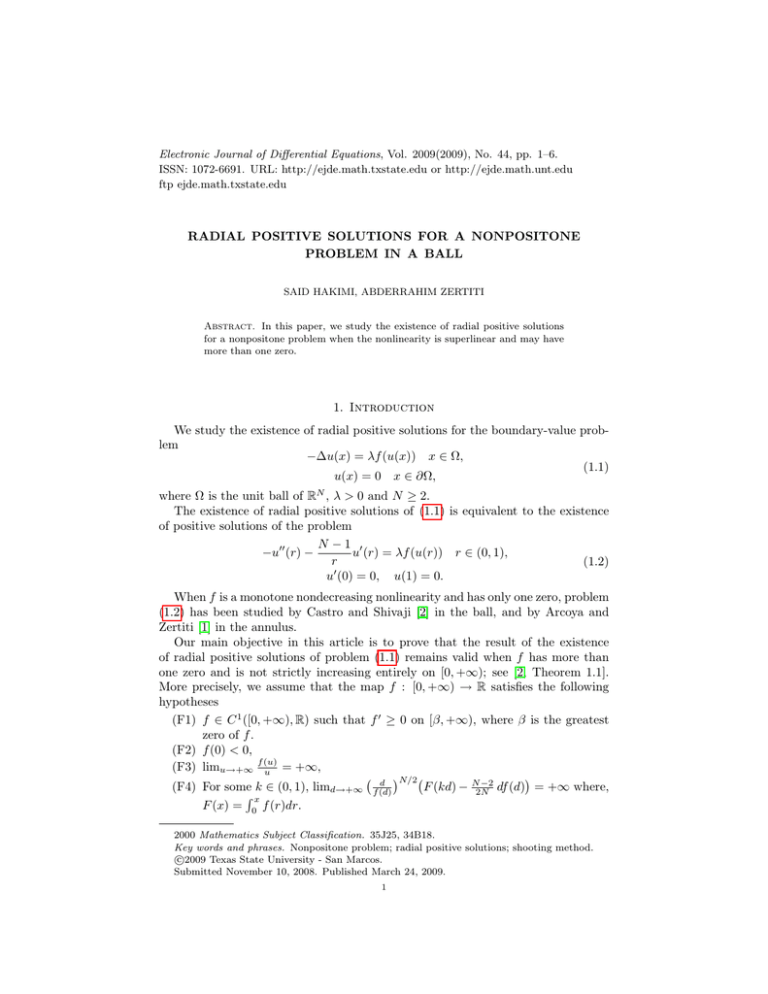
Electronic Journal of Differential Equations, Vol. 2009(2009), No. 44, pp. 1–6.
ISSN: 1072-6691. URL: http://ejde.math.txstate.edu or http://ejde.math.unt.edu
ftp ejde.math.txstate.edu
RADIAL POSITIVE SOLUTIONS FOR A NONPOSITONE
PROBLEM IN A BALL
SAID HAKIMI, ABDERRAHIM ZERTITI
Abstract. In this paper, we study the existence of radial positive solutions
for a nonpositone problem when the nonlinearity is superlinear and may have
more than one zero.
1. Introduction
We study the existence of radial positive solutions for the boundary-value problem
−∆u(x) = λf (u(x)) x ∈ Ω,
(1.1)
u(x) = 0 x ∈ ∂Ω,
where Ω is the unit ball of RN , λ > 0 and N ≥ 2.
The existence of radial positive solutions of (1.1) is equivalent to the existence
of positive solutions of the problem
N −1 0
−u00 (r) −
u (r) = λf (u(r)) r ∈ (0, 1),
r
(1.2)
u0 (0) = 0, u(1) = 0.
When f is a monotone nondecreasing nonlinearity and has only one zero, problem
(1.2) has been studied by Castro and Shivaji [2] in the ball, and by Arcoya and
Zertiti [1] in the annulus.
Our main objective in this article is to prove that the result of the existence
of radial positive solutions of problem (1.1) remains valid when f has more than
one zero and is not strictly increasing entirely on [0, +∞); see [2, Theorem 1.1].
More precisely, we assume that the map f : [0, +∞) → R satisfies the following
hypotheses
(F1) f ∈ C 1 ([0, +∞), R) such that f 0 ≥ 0 on [β, +∞), where β is the greatest
zero of f .
(F2) f (0) < 0,
(F3) limu→+∞ f (u)
u = +∞,
N/2
d
−2
(F4) For some k ∈ (0, 1), limd→+∞ f (d)
F (kd) − N2N
df (d) = +∞ where,
Rx
F (x) = 0 f (r)dr.
2000 Mathematics Subject Classification. 35J25, 34B18.
Key words and phrases. Nonpositone problem; radial positive solutions; shooting method.
c
2009
Texas State University - San Marcos.
Submitted November 10, 2008. Published March 24, 2009.
1
2
S. HAKIMI, A. ZERTITI
EJDE-2009/44
Remark. We note that in hypothesis (F1) there is no restriction on the function
f (u) for 0 < u < β.
Remark. It is well known (see [3]) that all positive solutions u of problem (1.1)
are radial with ∂u
∂r < 0 in Ω. This fact permits the authors in [1, 2] to apply the
shooting method when f satisfies some suitable hypotheses.
In this paper, we follow the work of Castro and Shivaji [2] and we used similar
ideas (adapted to our case) in the work of Iaia and Pudipeddi [4]. So we apply
the shooting method. For this, we consider the initial auxiliary boundary-value
problem
−u00 (r) −
N −1 0
u (r) = λf (u(r)) r ∈ (0, 1),
r
0
u (0) = 0, u(0) = d,
where d is the parameter of the shooting method.
It has been shown [2] that for each real number d, the above auxiliary problem
has a unique solution u(t, d, λ) satisfying the following property: if (dn , λn ) → (d, λ)
as n → +∞, then {u(., dn , λn )} converges to u(., d, λ) on [0, 1].
2. The main Result
In this section, we shall give the main result of this work. More precisely, we
have the following theorem.
Theorem 2.1. Assume that the hypotheses (F1)–(F4) are satisfied. Then there
exists a positive real number λ0 such that if λ ∈]0, λ0 [, problem (1.1) has at least
one radial positive solution which is decreasing on [0, 1].
The proof of this theorem is based on the three next technical Lemmas in this
section. We note that the proofs of the first two Lemmas are analogous with those
of [2, Lemmas 3.1 and 3.2]. On the opposite, the proof of the last Lemma, in our
work, is different from that of [2, Lemma 3.3]. This is due to that in our case f
may have many zeros and isn’t increasing entirely on [0, +∞).
Following [2], we introduce the notation and the following preliminaries. Denote
by θ the greatest zero of F . From (F4), we can choose γ ≥ sup{ βk , kθ } such that
2N F (kd) − (N − 2)df (d) ≥ 1,
∀d ≥ γ.
(2.1)
Moreover, for d ≥ γ there exists t0 ∈ (0, 1] such that
and kd ≤ u(t, d, λ) ≤ d,
u(t0 , d, λ) = kd
∀t ∈ [0, t0 ].
(2.2)
Taking into account that f is nondecreasing on [kd, d] ⊂ (β, +∞) and that
Z t
0
−(N −1)
u (t, d, λ) = −λt
rN −1 f (u(r))dr,
0
we obtain from this and (2.2)
λf (d)
λf (kd)
t ≤ −u0 ≤
t
N
N
and integrating on [0, t0 ]
c1
d 1/2
d 1/2
≥ t0 ≥ c1
,
λf (kd)
λf (d)
(2.3)
EJDE-2009/44
POSITIVE SOLUTIONS FOR A NONPOSITONE PROBLEM
3
where c1 = (2N (1 − k))1/2 . Next given d ∈ R and λ ∈ R, we define
u0 (t, d, λ)2
+ λF (u(t, d, λ)).
2
N −2
H(t, d, λ) = tE(t, d, λ) +
u(t, d, λ)u0 (t, d, λ).
2
Then, we show the following identity of Pohozaev type:
tN −1 H(t, d, λ) = b
tN −1 H(b
t, d, λ)
Z t
N −2
f (u(r, d, λ))u(r, d, λ)}dr.
+λ
rN −1 {N F (u(r, d, λ)) −
2
b
t
E(t, d, λ) =
Taking b
t = 0 and t = t0 in the previous identity and using (2.2) and (2.3), we show
as in [2]:
N
N −2
d N/2
−1
f (d)d}{
}
,
(2.4)
tN
H(t0 , d, λ) ≥ c2 λ1− 2 {F (kd) −
0
2N
f (d)
where c2 = cN
1 .
Lemma 2.2. There exists λ1 > 0 such that u(t, γ, λ) ≥ β for all λ ∈ (0, λ1 ) and
for all t ∈ [0, 1].
Proof. Let t1 = sup{t ≤ 1 : u(r, γ, λ) ≥ β, ∀r ∈ (0, t)}. Since f ≥ 0 on [β, +∞) and
Rt
u0 (t, γ, λ) = −λt−(N −1) 0 rN −1 f (u(r, γ, λ))dr, u is decreasing on [0, t1 ]. Again, for
all t ∈ [0, t1 ], we have
λ f (γ)
< γ − β,
|u0 (t, γ, λ)| ≤
N
by assuming that λ < λ1 = N f(γ−β)
(γ) . After that, by using the mean value theorem,
we obtain for all λ ∈ (0, λ1 ):
u(t1 , γ, λ) − u(0, γ, λ) = u(t1 , γ, λ) − γ ≥ −(γ − β)t1 .
If t1 < 1, then u(t1 , γ, λ) > β, which contradicts the definition of t1 . Thus t1 = 1
and the lemma is proved.
Lemma 2.3. There exists λ2 > 0 such that if λ ∈ (0, λ2 ), then
2
2
u(t, d, λ) + u0 (t, d, λ) > 0,
∀t ∈ [0, 1], ∀d ≥ γ.
Proof. For t ≥ t0 , the identity of Pohozaev type gives
Z t
N −2
N −1
N −1
t
H(t) = t0 H(t0 ) + λ
rN −1 {N F (u) −
f (u)u}dr.
2
t0
Extending f by f (x) = f (0) < 0, for all x ∈ (−∞, 0], there exists B < 0 such that
N −2
N F (s) −
f (s)s ≥ B, ∀s ∈ R.
2
By (F4), we can take γ sufficiently large such that
N −2
d N/2
{F (kd) −
df (d)}{
}
≥ 1 ∀d ≥ γ,
2N
f (d)
and using inequality (2.4), we obtain
N
tN −1 H(t) ≥ c2 λ1− 2 {F (kd) −
N −2
d N/2
tN − tN
0
df (d)}{
}
+ λB
,
2N
f (d)
N
(2.5)
4
S. HAKIMI, A. ZERTITI
EJDE-2009/44
then
B
), ∀t ∈ [t0 , 1].
N
Hence, there exists λ2 such that for all λ ∈ (0, λ2 ), H(t) > 0 for all t ∈ [0, 1] and
for all d ≥ γ. This implies that u2 (t) + u0 (t)2 > 0, for all t ∈ [0, 1], for all d ≥ γ. N
tN −1 H(t) ≥ λ(c2 λ− 2 +
Lemma 2.4. Given any λ > 0, there exists d ≥ γ such that u(t, d, λ) < 0 for some
t ∈ [0, 1].
Proof. Let d ≥ γ. We put t = sup{t ∈ (0, 1) : u(., d, λ) is decreasing on (0, t)}. Let
ω be such that
N −1 0
ω + %ω = 0,
ω 00 +
r
ω(0) = 1, ω 0 (0) = 0,
where % is chosen such that the first zero of ω is 4t .
We argue by contradiction. Suppose that u(t, d, λ) ≥ 0 for all t ∈ [0, 1] and all
d ≥ γ. By (F3), there exists d0 ≥ γ such that
f (x)
%
≥ , ∀x ≥ d0 .
(2.6)
x
λ
On the other hand, since (dω)00 + N r−1 (dω)0 +%(dω) = 0 and u00 + N r−1 u0 +λf (u) = 0,
we obtain
Z t
f (u(s))
N −1
0
0
t
[u(t)v(t) − v(t)u(t) ] =
sN −1 [λ
− %]u(s)v(s)ds,
u(s
0
where v = dω. Therefore, if u(t, d, λ) ≥ d0 , for all t ∈ [0, 4t ], we obtain from (2.6),
Z t
f (u(s))
− %]u(s)v(s)ds ≥ 0,
sN −1 [λ
u(s)
0
so that
t
(2.7)
u(t)v 0 (t) − v(t)u0 (t) > 0, ∀t ∈ (0, ].
4
Thus, taking into account that v( 4t ) = 0, v 0 ( 4t ) < 0, we have
t 0 t
t 0 t
v
−v
u
< 0.
4
4
4
4
This is a contradiction with (2.7). Hence, there exists t∗ in (0, t/4) such that
u(t∗ , d, λ) = d0 and since d0 ≥ γ > β there exists b
t ∈ (t∗ , t) such that
u
β ≤ u(t, d, λ) ≤ d0 ,
∀t ∈ (t∗ , b
t).
(2.8)
Now, we consider the point t0 defined in (2.2). It is clear that t0 < t.
On [0, t0 ], since F is nondecreasing on [β, +∞[ and u(t, d, λ) ≥ kd ≥ β, for all
t ∈ (0, t0 ], we have
u0 (t, d, λ)2
+ λF (u(t, d, λ)) ≥ λF (kd).
2
On the other hand, since u(t, d, λ)u0 (t, d, λ) ≤ 0 for all t ∈ (t0 , t], we have
N − 2 N −1
tN E(t, d, λ) = tN −1 H(t, d, λ) −
t
u(t, d, λ)u0 (t, d, λ)
2
≥ tN −1 H(t, d, λ),
E(t, d, λ) =
(2.9)
EJDE-2009/44
POSITIVE SOLUTIONS FOR A NONPOSITONE PROBLEM
5
hence, by (2.5), we obtain
N
tN E(t, d, λ) ≥ c2 λ1− 2 {F (kd) −
N −2
d N/2
tN − tN
0
df (d)}{
}
+ λB
.
2N
f (d)
N
(2.10)
Now from (F4), (2.9) and (2.10) we obtain limd→+∞ E(t, d, λ) = +∞ uniformly
with respect to t ∈ [0, t]. Hence there exists d1 ≥ d0 such that for all d ≥ d1 ,
E(t, d, λ) ≥ λF (d0 ) +
2
d20 ,
b
(t − t∗ )2
∀t ∈ [0, t].
Taking into account (2.8), this implies
4
d20 + 2λ(F (d0 ) − F (u(t, d, λ)))
b
(t − t∗ )2
4
≥
d20 , ∀t ∈ (t∗ , b
t),
b
(t − t∗ )2
u0 (t, d, λ)2 ≥
2
∗ b
which implies u0 (t, d, λ) ≤ − bt−t
∗ d0 , for all t ∈ (t , t).
∗
The mean value theorem gives us c ∈ (t∗ , t
u(
∗
+b
t
2 )
such that
b
b
t + t∗
2d0 b
t − t∗
t − t∗
) − u(t∗ ) = u0 (c)
≤−
.
= −d0 .
∗
b
2
2
2
t−t
∗
2
Hence u( t 2+t ) ≤ 0 and since u0 ( t 2+t ) ≤ − bt−t
∗ d0 < 0, there exists T ∈ (0, 1) such
that u(T, d, λ) < 0 which is a contradiction. So the proof is finished.
b
b
Remark 2.5. In [2], to prove the last lemma, the authors use the fact that if
u(t, d, λ) ≤ β, where β is the only zero of f , then F (u(t, d, λ)) ≤ 0, which simplifies
the proof.
In our case, even if u(t, d, λ) ≤ β we do not have F (u(t, d, λ)) ≤ 0, and we have
overcome this problem.
Proof of theorem 2.1. As in [2], we take λ ∈ (0, λ0 ) where λ0 = min{λ1 , λ2 }. Let
db = sup{d ≥ γ : u(t, d, λ) ≥ 0 , ∀t ∈ (0, 1]}.
Lemma 2.2 leads to the fact that the set {d ≥ γ : u(t, d, λ) ≥ 0, ∀t ∈ [0, 1]} is
b λ) is the
nonempty. By Lemma 2.4, we have db < +∞, and we claim that u(., d,
desired solution, which satisfies the following properties
b λ) > 0, for all t ∈ [0, 1),
(i) u(t, d,
b λ) = 0,
(ii) u(1, d,
0
b λ) < 0,
(iii) u (1, d,
(iv) u is decreasing in [0, 1].
b λ) = 0. By
To prove (i), we assume that there exists T1 < 1 such that u(T1 , d,
0
0
b
b
Lemma 2.3, u (T1 , d, λ) 6= 0. We can assume (see [2]) that u (T1 , d, λ) < 0, then
b λ) < 0, which is a contradiction with the
there exists T2 ∈ (T1 , 1) such that u(T2 , d,
b
definition of d.
b λ) > 0, then there exists η > 0 such that u(t, d,
b λ) ≥ η
For(ii), we assume u(1, d,
η
b
for all t ∈ (0, 1]. Again there exists δ > 0 such that u(t, d+δ, λ) ≥ 2 for all t ∈ (0, 1],
b
which is a contradiction with the definition of d.
Statement (iii) is a consequence of Lemma 2.3; and (iv) is a result of [3].
6
S. HAKIMI, A. ZERTITI
EJDE-2009/44
References
[1] D. Arcoya and A. Zertiti; Existence and non-existence of radially symmetric non-negative
solutions for a class of semi-positone problems in annulus, Rendiconti di Matematica, serie
VII, Volume. 14, Roma (1994), 625-646.
[2] A. Castro and R. Shivaji; Non-negative solutions for a class of radially symmetric nonpositone
problems, Proc. Amer. Math. Soc., 106, n.3 (1989), 735-740.
[3] B. Gidas, W.M. NI, L. Nirenberg; symmetry and related properties via the maximum principle,
commun. Math Phys., 68 (1979), 209-243.
[4] J. Iaia, S. Pudipeddi; Radial Solutions to a Superlinear Dirichlet Problem Using Bessel Functions, Electronic Journal of Qualitative Theory of Differential Equations, 2008, no. 38, pp.
1-13.
Said Hakimi
Université Abdelmalek Essaadi, Faculté des sciences, Département de Mathématiques,
BP 2121, Tétouan, Morocco
E-mail address: h saidhakimi@yahoo.fr
Abderrahim Zertiti
Université Abdelmalek Essaadi, Faculté des sciences, Département de Mathématiques,
BP 2121, Tétouan, Morocco
E-mail address: zertitia@hotmail.com
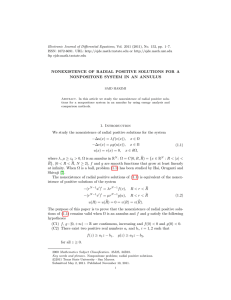
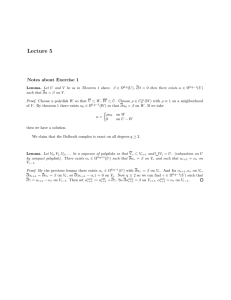
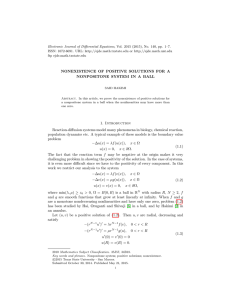
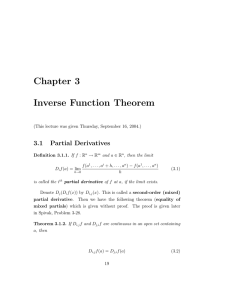
![arXiv:1608.02703v1 [math.NT] 9 Aug 2016](http://s2.studylib.net/store/data/018116708_1-e7a81418706a05c148bca971b089a143-300x300.png)
![[A]ω - American Mathematical Society](http://s2.studylib.net/store/data/018049051_1-c0f4be6bde3c21aa6ac2bbf33e04dd05-300x300.png)
